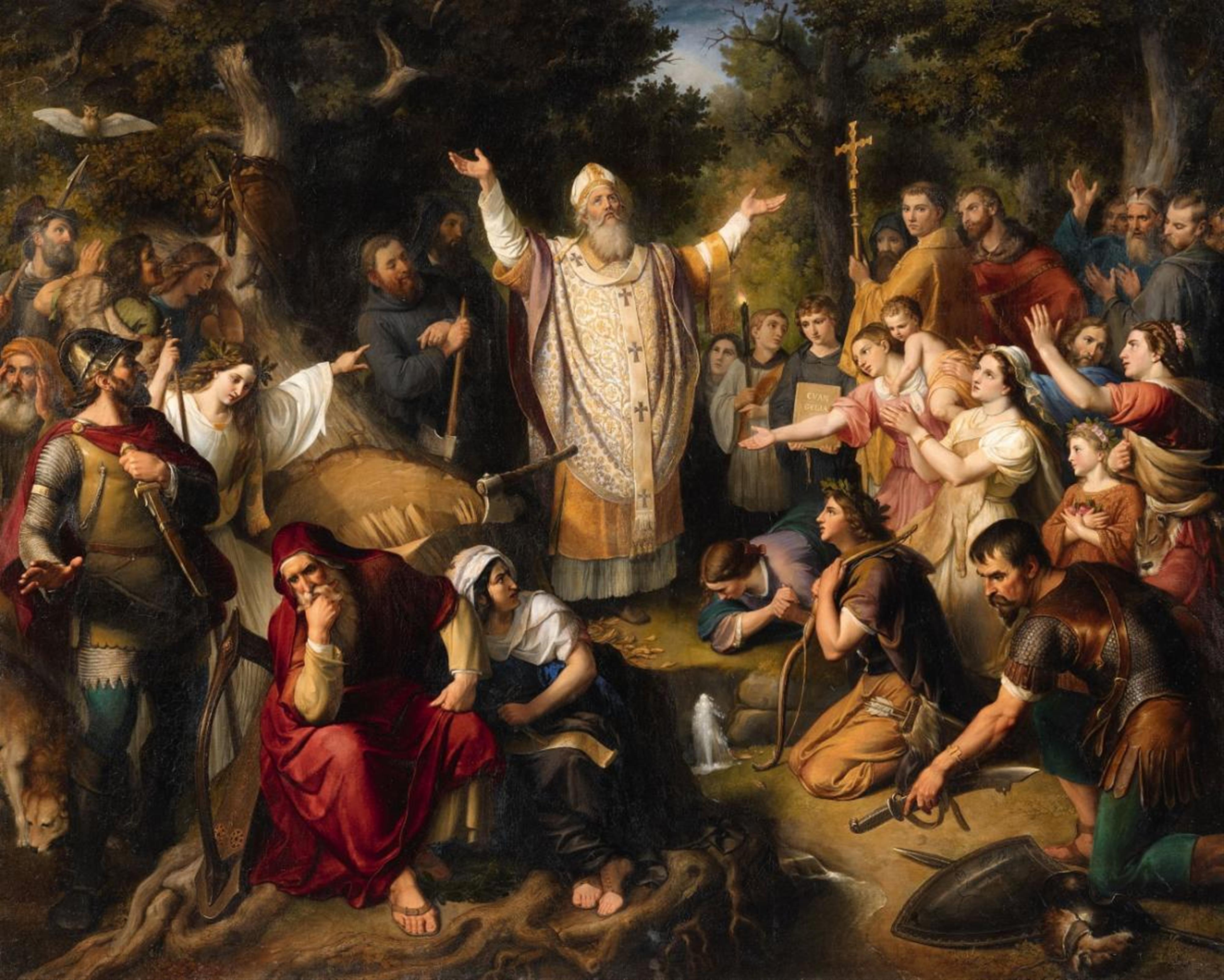Johann Michael Wittmer
Saint Boniface Felling Donar's Oak
Oil on canvas. 166 x 208.5 cm.
Signed and dated upper left: MICHAEL WITTMER F. ROMA MDCCCLXI (on the plaque on the tree).
The painting “Saint Boniface Felling Donar's Oak” is returning to Cologne after having been exhibited here for the first time one year after its completion in 1861. Johann Michael Wittmer, who resided in Rome as of 1828, exhibited the piece together with two of his other works in the “Zweiten allgemeinen deutschen und historischen Kunstausstellung“ on 1st July 1861 in the Wallraf-Richartz Museum, which had recently opened in the grounds of the former Minorite Abbey. The painting was returned to the artist after the exhibition and has remained until now in the private collection of his descendants in Italy.
Wittmer spent fifty years of his life in Rome and belonged to the famous circle of German painters and authors residing in this city in the late 18th and 19th centuries. Born in Upper Bavarian, he was taught - among others - by Peter von Cornelius at the Munich Academy. He accompanied the Bavarian Crown Prince Maximillian on a sojourn to Sicily, Greece, Constantinople and Asia Minor in 1833, and married the daughter of Anton Koch - the intellectual leader of the German-Roman painters - in the same year. Wittmer was primarily a narrative painter, covering historical, mythological and religious motifs. The artist belonged to the later generation of the Nazarenes, and as such his style is most closely related to theirs. Among other illustrious patrons, his works were collected by the Royal houses of Bavaria, Württemberg and Great Britain.
A brilliant comprehensive study of historical sources carried out by Brigitte Salmen provides us with a wealth of information on this painting's development. According to this study, the artist began planning the motif as a possible subject for the decoration of the Bavarian National Museum in Munich, which had been reopened in 1855. Although he never received an official commission from the museum, he still continued working on the painting and completed it in 1861. A sketch of the motif in ink which Wittmer sent to the Bavarian King Maximilian II in 1860 is now considered lost (cf. Salmen ibid., p. 298, no. 274, illus. 217).
St. Boniface, who is venerated as the “Apostle of the Germans“, worked as a missionary and church reformer in the Frankish Empire during the early 8th century. He founded numerous abbeys and bishoprics, always making sure the churches he erected were built facing Rome. One of the most well-known events in the life of the Saint is his felling of Donar's Oak, a tree sacred to the God Thor which grew in the area around what is now Fritzlar, possibly in the spot where the Cathedral stands today. After Boniface cut down this symbol of pagan faith, many feared the vengeance of the Germanic God which it stood for. However, when the wrath of Thor never came, Boniface took this as a sign of Christianity's superiority over the old Gods and the heathen faith.
The present large format work depicts this famous scene from the life of the Apostle of the Germans. The imposing figure of the Saint is shown in the centre of the composition in his Bishop's robes with his hands raised to the heavens. He is surrounded by a multitude of thronging figures of both pagans and his followers. The felled oak is depicted in the background, foreshortened but still towering above the scene, bearing a plaque signed by the artist and inscribed “Roma MDCCCLXI”.
In a letter of 20.05.1861 to Ottilie, the daughter-in-law of Wolfgang von Goethe, Wittmer writes of this piece: “I am currently working on a large and opulent painting of Saint Boniface thanking God after the felling of Donar's Oak, and the Christian joy at the fall of the heathens. It is one of the most successful and wonderful moments in our history. I hope to have the luck of finding a place for this work in our fatherland someday.” (from the German, in a letter from the Goethe- und Schiller- Archive in Weimar, GSA 40/XX,3,9, cit. from Salmen, ibid. p. 80). Sadly, the artist's wish has as yet not been fulfilled.
Provenance
Private collection, Italy (the work has been in the possession of the artist's heirs since its creation).
Literature
Brigitte Salmen: Johann Michael Wittmer (1802-1880). Studien zu Leben und Werk, Diss. Passau 2006, Online-Publikation, p. 298, no. 276, illus. 219, and p. 78-81.
Exhibitions
Zweite allgemeine deutsche und historische Kunstausstellung, Cologne, Museum Wallraf-Richartz, 1861, no. 905.

